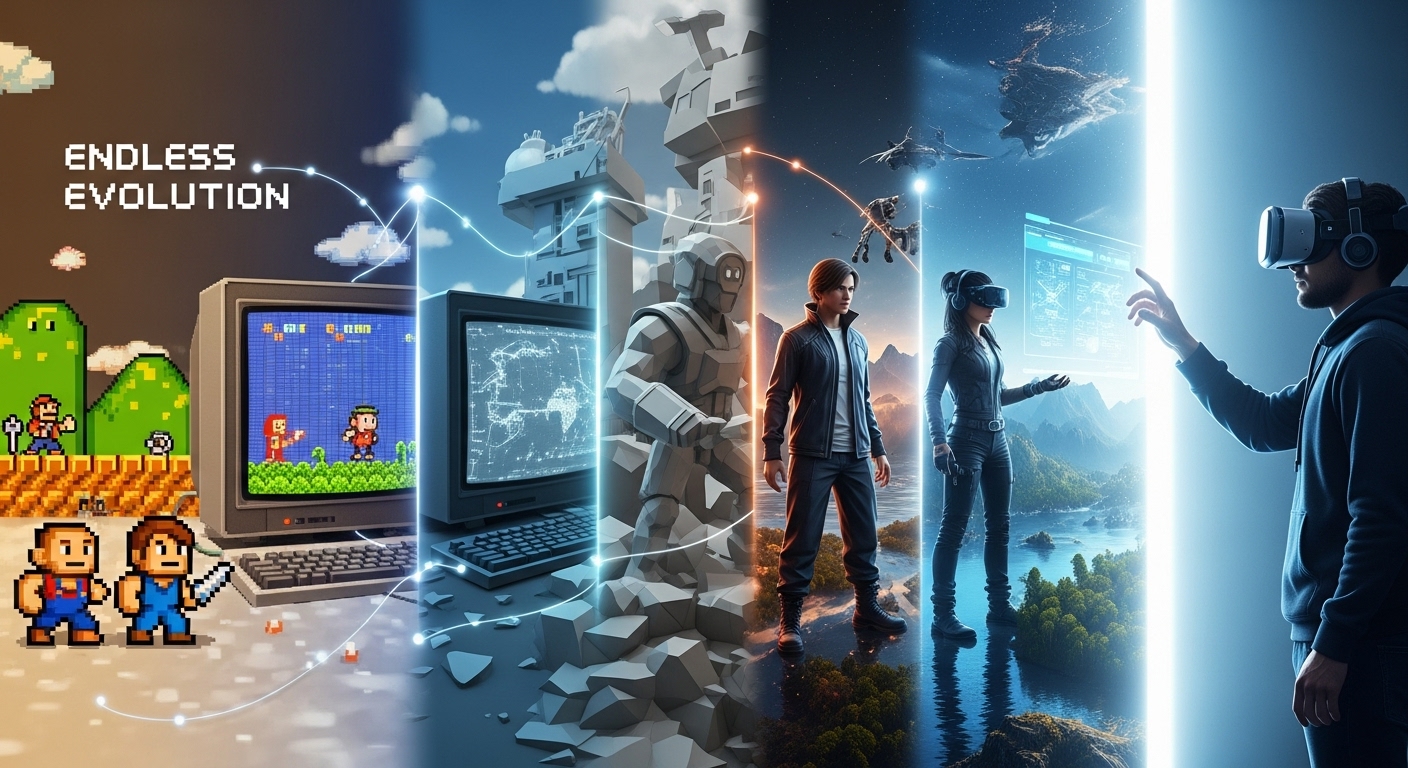Introduction: Gaming as a Cultural Force
In recent years, gaming has transformed from a hobby enjoyed by a niche community to a mainstream cultural phenomenon. It has become one of the largest industries in the world, generating billions in revenue annually. Yet, despite its financial success, gaming is not just about the numbers—it’s a powerful medium that influences culture, technology, and even social behaviors.
From the first arcade machines of the early 1970s to the immersive virtual worlds of today, gaming has seen tremendous growth. The evolution of gaming mirrors the rapid advancement of technology and the changing interests of society. As gaming continues to evolve, it leaves an indelible mark on the entertainment landscape. In this blog post, we will explore the fascinating journey of video gaming, its impact on culture, the role of technology, and where the future of gaming might take us.
The Humble Beginnings: The Birth of Video Games
The First Glimpse of Gaming
The history of video games dates back to the late 1950s, although the games we recognize today did not come into existence until the 1970s. Early gaming was experimental, often built on computer systems used for academic and military purposes. One of the first known examples of a video game was Tennis for Two, created in 1958 by William Higinbotham. It was a simple tennis simulation displayed on an oscilloscope, a device used for scientific measurements, and it had no widespread commercial potential.
Around the same time, Spacewar! (1962) was created by Steve Russell at MIT. Unlike Tennis for Two, Spacewar! became more widely circulated across university campuses. It is often considered one of the first “true” video games and would go on to inspire the development of commercial games in the years that followed.
The Arcade Explosion
The 1970s marked the beginning of video games as a commercial enterprise. In 1972, Atari founder Nolan Bushnell introduced Pong, a simple two-player arcade game that simulated ping-pong. Pong was an immediate success, generating attention from the public and establishing the arcade as the birthplace of video gaming.
For the next several years, arcades thrived as the go-to destination for video gaming enthusiasts. Games like Space Invaders (1978), Asteroids (1979), and Pac-Man (1980) became iconic and were responsible for attracting millions of players into arcades. The cultural impact of arcade gaming during this period cannot be overstated—arcades became social hubs where people of all ages gathered to play games, compete for high scores, and share experiences.
The Rise of Home Consoles: From Arcades to Living Rooms
The Birth of Home Consoles
While arcade games were enjoying massive success, the idea of playing video games at home was still a distant dream. However, in 1972, the Magnavox Odyssey became the first home video game console to offer players a chance to play games on their TV sets. It came bundled with a handful of simple games like Table Tennis, which mimicked the gameplay of Pong. Though rudimentary by today’s standards, the Odyssey represented the first step toward home gaming.
The real shift to home gaming happened in the late 1970s with the launch of the Atari 2600 in 1977. The Atari 2600 was a revolutionary console that allowed users to swap game cartridges, each offering a unique experience. The success of the Atari 2600 made it clear that video games could be a staple of home entertainment, and other companies soon followed suit, creating their own consoles and games.
The 1980s saw the advent of more advanced gaming systems, with the Nintendo Entertainment System (NES) (1985) and Sega Genesis (1988) leading the charge. These consoles introduced players to a host of iconic games, such as Super Mario Bros., The Legend of Zelda, and Sonic the Hedgehog. These franchises not only helped solidify home gaming as a mainstream activity but also laid the foundation for long-lasting franchises that continue to dominate the gaming world today.
The Rise of Competition: Console Wars
During the 1980s and 1990s, the video game industry became increasingly competitive. The battle for dominance between gaming giants like Nintendo, Sega, and later Sony defined this era. Nintendo’s success with the NES was followed by its even more successful Super Nintendo Entertainment System (SNES), which introduced players to beloved titles like Super Mario World and The Legend of Zelda: A Link to the Past.
Meanwhile, Sega entered the market with the Sega Genesis, which took the fight to Nintendo with titles like Sonic the Hedgehog and Mortal Kombat. The console wars between Nintendo and Sega were intense and gave birth to one of the most passionate rivalries in gaming history. The rivalry led to innovations on both sides, with each company working hard to outdo the other in terms of hardware and game development.
In the late 1990s, Sony entered the scene with the PlayStation, a new console that would eventually redefine the industry. The original PlayStation, released in 1994, offered advanced 3D graphics, a CD-based game format, and iconic titles like Final Fantasy VII and Gran Turismo. The PlayStation’s success led to the rise of Sony as a dominant force in the gaming industry, further intensifying the competition in the market.
The 3D Revolution: A Leap Into the Future
The Shift to 3D Graphics
The 1990s was a transformative time for gaming, largely due to the shift from 2D to 3D graphics. As technology advanced, gaming consoles and personal computers were able to render 3D environments, a leap that fundamentally changed the way video games were designed and played.
One of the most influential titles during this time was Super Mario 64, which was released in 1996 for the Nintendo 64. This was one of the first games to introduce players to an open-world 3D environment, allowing players to explore vast, interactive worlds. Super Mario 64 set the stage for a new era of gaming, where exploration, movement, and freedom became central to the experience.
The PlayStation also embraced 3D technology with games like Gran Turismo (1997), which was one of the first racing games to use realistic 3D environments and physics, and Final Fantasy VII (1997), which combined 3D visuals with a compelling narrative and turn-based combat.
The Rise of Online Multiplayer Gaming
As broadband internet became more widely available in the late 1990s and early 2000s, the idea of playing video games online began to take hold. While early online gaming existed in some form on PCs, it was on consoles where online multiplayer gaming truly took off.
The Microsoft Xbox, released in 2001, introduced Xbox Live, an online gaming service that allowed players to connect to the internet and compete with others in real-time. The service’s success was helped by the release of Halo 2 (2004), a game that became a massive hit and is often credited with popularizing online first-person shooters.
On the PC side, games like Counter-Strike and World of Warcraft helped push online gaming forward. World of Warcraft (2004), in particular, became a cultural phenomenon, drawing millions of players into its persistent, online world. MMOs (Massively Multiplayer Online games) became a staple genre, allowing players to live out their virtual lives in expansive, shared environments.
The Rise of Mobile Gaming and Casual Players
The Mobile Gaming Boom
While console and PC gaming remained dominant, a new form of gaming emerged in the 2000s—mobile gaming. With the release of smartphones, gaming became more accessible than ever before. Mobile games such as Angry Birds (2009), Candy Crush Saga (2012), and Clash of Clans (2012) introduced a whole new demographic to gaming, appealing to casual players who may have never considered gaming before.
Mobile games are designed for quick, casual play, often featuring simple mechanics and addictive gameplay loops. These games rely heavily on microtransactions to generate revenue, allowing players to purchase in-game items and boosts to enhance their gaming experience.
The success of mobile gaming led to an explosion of apps in the early 2010s, and the mobile gaming market grew to become one of the most lucrative sectors in the gaming industry.
The Impact of Gaming on Society and Culture
Gaming as a Social Experience
While gaming was once considered a solitary activity, it has evolved into a highly social experience. Multiplayer games, online communities, and streaming platforms like Twitch have turned gaming into a shared experience that connects people across the globe.
Games like Fortnite (2017) and Minecraft (2011) have become more than just games; they are platforms for socializing and collaboration. Players team up with friends or meet new people from around the world to complete missions, build worlds, or simply hang out.
The rise of e-sports also turned competitive gaming into a spectator sport. Major tournaments for games like League of Legends, Dota 2, and Overwatch now offer multi-million-dollar prize pools and attract millions of viewers, both online and in person.
Gaming and Representation
Another significant change in the gaming landscape is the increasing focus on representation. Historically, the gaming industry has been criticized for its lack of diversity in both characters and game development. However, over the past decade, there has been a conscious effort to address these issues. Games like The Last of Us Part II (2020), which features a diverse cast of characters and explores LGBTQ+ themes, represent a shift towards more inclusive and nuanced storytelling in gaming.
The gaming community itself has also become more diverse, with more women, people of color, and LGBTQ+ individuals becoming involved in both the development and consumption of games. This evolution is reshaping the narrative of what gaming is and who it’s for.
The Future of Gaming: What’s Next?
Virtual Reality and Augmented Reality
The next frontier for gaming lies in immersive experiences. Virtual reality (VR) and augmented reality (AR) are poised to revolutionize the way we interact with games. VR gaming immerses players in fully interactive 3D environments, offering a sense of presence and physicality that was previously unimaginable. Games like Beat Saber (2018) and Half-Life: Alyx (2020) are leading the charge in VR gaming, offering players the chance to experience gaming in an entirely new way.
On the other hand, AR gaming blends the real world with digital elements. Pokémon Go (2016) was one of the first massive AR games to gain widespread popularity, and as AR technology improves, we can expect more games to integrate the real world into their gameplay.
Cloud Gaming and Streaming
Cloud gaming is another trend that is shaping the future of gaming. Platforms like Google Stadia, Xbox Cloud Gaming, and Nvidia GeForce Now allow players to stream games directly to their devices without the need for powerful hardware. As internet speeds improve and cloud infrastructure becomes more reliable, cloud gaming could become the dominant way to play games.
Conclusion: Gaming’s Ever-Growing Influence
From its humble beginnings in the 1950s to the global powerhouse it is today, gaming has come a long way. Its evolution reflects not only technological advancements but also shifts in society and culture. Gaming is now a vital part of our social fabric, a tool for entertainment, competition, and self-expression. As we look to the future, the world of gaming promises to continue pushing the boundaries of creativity, storytelling, and technology. Whether through virtual reality, mobile gaming, or the ever-expanding world of e-sports, the journey of gaming is far from over—and the best is yet to come.



